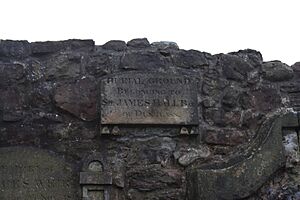Sir James Hall, 4th Baronet facts for kids
Sir James Hall of Dunglass, 4th Baronet (born January 17, 1761 – died June 23, 1832) was an important Scottish scientist. He was a geologist, who studies Earth's rocks and history, and a geophysicist, who studies Earth's physical processes. He was also a Member of Parliament, which means he was elected to help make laws for the country, representing the area of Mitchell in Cornwall from 1807 to 1812.
Contents
Early Life and Learning
James Hall was born at Dunglass Castle, East Lothian, in Scotland. His parents were Sir John Hall, 3rd Baronet, and Magdalena Pringle. He went to two famous universities: Christ's College, Cambridge, and the University of Edinburgh.
While studying in Edinburgh in the 1780s, James Hall learned about chemistry from a famous scientist named Joseph Black. He also studied natural history with John Walker. Professor Walker was one of the first teachers to give proper lessons on the new subject of geology. Hall learned how to use the chemical makeup of rocks to figure out how old they were.
After his studies, Hall traveled around Europe. He looked for books on chemistry, rocks, and geology. He even met a famous French chemist named Lavoisier. When he returned to Scotland, he helped share new ideas about chemistry from France.
At his home, Dunglass Castle, James Hall built a huge model of a cathedral, about 3 meters tall. It was based on a part of Westminster Abbey. He made it from willow branches, and some of them actually grew roots! This turned his model into a small group of trees.
Exploring Earth's Secrets
James Hall was very interested in James Hutton's Theory of the Earth in the late 1700s. Hutton's idea was that Earth's layers of rock are always being worn down or melted. This means the Earth is like a giant system where materials are always moving and changing.
In 1788, Hall went on a boat trip with James Hutton and John Playfair along the coast of Scotland. They found a famous rock formation called Hutton's Unconformity at Siccar Point. This place showed how different layers of rock were laid down at different times, proving Hutton's ideas.
At first, Hall wasn't sure about the chemistry behind Hutton's theory. But he soon understood it better and wrote several papers about the chemical makeup of rock layers.
Experiments with Rocks
James Hall did amazing experiments to understand how rocks form.
- He studied granite and showed that melted rock could form new layers.
- He melted a type of rock called basalt in a hot furnace. He proved that it returned to its original form when it cooled down.
- He also melted limestone inside a strong metal container (made from a gun barrel!). He showed that limestone doesn't break down when melted under high pressure.
His findings were published and were very popular, especially with scientists like John Playfair. They wanted to use Hutton's ideas to make geology more like a mathematical science.
Studying Folds in Rocks
In 1815, James Hall also did the first analogue modelling experiments. This means he used small models to understand how large rock formations, like folds in mountains, are created.
He traveled a lot in Europe to see geological formations, like the Alps mountains and the Mount Etna volcano. He noticed that the lava flows in Italy looked very similar to some places in Scotland.
Sir James Hall became the President of the Royal Society of Edinburgh, which is a famous group of scientists. He also wrote many works about building design and science.
Family Life
James Hall married Helen Douglas. They had three daughters and three sons.
He passed away at his home in Edinburgh, Scotland. He is buried in Greyfriars Kirkyard, a historic cemetery in central Edinburgh. His grave is against the western wall of the old churchyard.
His son, Sir John Hall, 5th Baronet, became the next Baronet and was also a scientist. Another son, Basil Hall, became a well-known traveler and writer. His daughter, Magdalene Hall, wrote a book called A Week at Waterloo.
See also
 In Spanish: James Hall (geólogo) para niños
In Spanish: James Hall (geólogo) para niños


